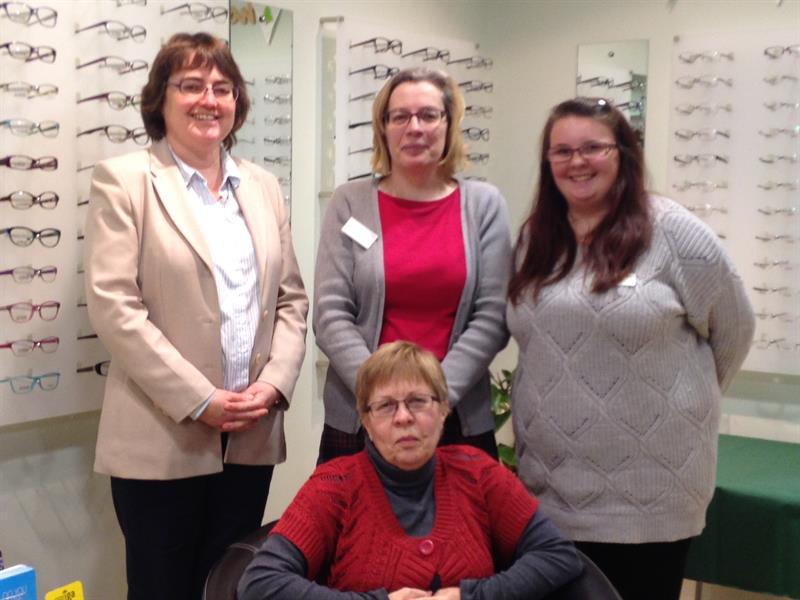Women have exceeded the number of men working in the optical profession for more than a decade now. The General Optical Council reported the number of female dispensing opticians exceeded the number of males for the first time in 2003 and the number of female optometrists exceeded males in 2005 and this trend has steadily continued. Currently, female optical professionals account for 59% of the fully qualified GOC register, while 70.3% of new undergraduates this year were female.
Modern optical practices are frequently open for late nights and at weekends compared to a generation ago when they stuck to Monday to Friday, 9am to 5pm, enabling many practitioners, including women with children, to work more flexible hours. The 2015 Optical Workforce Survey, led by the College of Optometrists, found that millennials (born in the 1980s and 1990s) place a greater emphasis than previous generations on maintaining a good work-life balance and flexible working is the main career preference for optometrists and dispensing opticians.
Henrietta Alderman, chief executive of the Association of Optometrists (AOP) says that it is important for the profession to provide flexibility and support for the increasing number of female practitioners. ‘Enabling women in optics to access the full range and breadth of roles that are available is essential to growing and developing the profession as a whole,’ she says.
The AOP offers flexible membership packages for members at different stages in their career with discounted grades for career breaks and part-time workers; a locum register that makes it simple to define and tailor working hours; CET events such as peer review roadshows to help women (and men) keep up-to-date with CET after a career break and a range of career workshops and online member forums. In-house employment law experts and a clinical and regulatory team are on hand to advise on everything from maternity leave to flexible working and general advice on returning to work.
Heidi Blakey, employment counsel for the AOP, says that enabling women to achieve their potential at work benefits individuals and businesses: ‘Employers should be aware of employees’ rights to make flexible working applications and they should be mindful of making changes to terms and conditions, which may impact more significantly on women with childcare responsibilities.’
Making the most of ‘keeping in touch days’ during maternity leave will help everyone feel more confident on the employee’s return to work, Blakey asserts, adding: ‘While it is natural to feel anxious about returning to work after a break, most practitioners are pleasantly surprised by how quickly their confidence returns. Working with a colleague for a few days and examining staff or family members before seeing “real” patients can build confidence and a supportive employer makes a big difference.’
Similarly, the Association of British Dispensing Opticians (Abdo) also offers reduced fees for those on a break from work and a dedicated CET department to help and support members considering part-time work or those coming back after a period of absence. It also offers ‘lifestyle’ benefits such as cinema discount vouchers, magazine subscription discounts and ‘cash back’ on everyday purchases such as groceries, which could save the cost of membership fees.
Abdo president Fiona Anderson says the Association is always striving to help its members, whether they are thinking of taking a break or restoring to the register. ‘Abdo is, just now, looking very closely at the changing demographics within our organisation and seeking to make it fit to serve our members in the coming years. We have already identified the shift from male to female and more and more mums and dads are seeking to work part-time. It is increasingly difficult to maintain a sensible work-life balance but I hope what Abdo does helps its members in some way and we are always looking for new and innovative ways to make a difference.’
Workplace legislation has evolved to help families balance work and home commitments. In addition to statutory maternity leave with enhanced benefits, employees are legally entitled to Shared Parental Leave (SPL) and Statutory Shared Parental Pay (SHPP) and many employers also offer childcare voucher schemes, offering greater flexibility for parents. See the box out on page 18.
Many optical practices, including the large multiples, now offer employees targeted benefits to help them achieve a good work-life balance. As the director of professional recruitment at Specsavers, Chris Howarth, says, the high volume of staff and long store opening hours makes it easier for optical chains, like Specsavers, to offer flexible working arrangements.
‘Our joint venture partners are well aware of the need to support women (and men) with young families and other carer responsibilities to achieve a work-life balance. Flexible working is usually in response to colleagues coming back from maternity leave or with other family care needs. In terms of career progression, there are numerous examples of optical professionals in our stores being actively encouraged to undertake training to develop their careers, whether they work full-time or part-time. If an individual is looking to progress their career, partners will do all they can to support that,’ he adds.
Optical Express offers women on maternity leave up to 10 ‘keeping in touch’ days with options for training in clinical skills; regular reviews with a clinical director as a key point of contact for support; in-house CET events; refresher training for refractive optometrists and special support for mothers who return to work while still breastfeeding.
Fiona Morton, head of HR projects at Optical Express, says: ‘We have a number of optometrists who take advantage of compressed hours, part-time hours, altered working patterns, fixed working patterns and working in locations to suit their needs, such as closer to home or their child’s nursery.’
Not that working at an independent practice means women will be short-changed when it comes to balancing work and family commitments. Grace Haine, a dispensing optician who manages an all-female team at her practice, Grace Haine Eyecare in Stalbridge, Dorset, says smaller practices are well-placed to offer flexibility for women with children.
‘It’s about making small adjustments and give-and-take. When my optometrist wanted to change her hours so that she could attend her son’s sports day recently we moved our clinic day. Sometimes we will finish a clinic early too so that she could make a parents’ evening. I know that she will, for example, give an extra Saturday if we need her to,’ she says.

Optometrist Karen Lockyer (pictured, left), who owns Karen Lockyer Optometrists in Clapham Junction, London, has two children aged 11 and 12. She also takes a flexible approach to managing employees with children. ‘I do employ women with families and I make allowances for them to finish early in order for them to collect their children from nursery or school. As a small business with a small team I try to be accommodating. I would happily offer employment to women on a part-time basis and only in term time if I came across any that were interested in this.’
Lockyer finds achieving a work-life balance for herself more challenging. She has worked in her practice since 1994, initially as an employee until she bought the practice from her employer in 2001. When she started a family she came back to work as quickly as she could. ‘I employed a locum optometrist for four months and then thought I could continue to run the practice remotely and come in occasionally. People told me that babies slept a lot so I had hopes of bringing my baby into practice to buy stock. Sadly my son hated it and screamed from the moment we arrived to the moment we left,’ she says. After putting her son into a day nursery, Lockyer eventually resorted to the more costly option of employing a full-time nanny as she found nursery drop-off and pick-up times too stressful with work commitments.
‘I found and continue to find the work-life balance challenging as I am the optometrist and business owner, which means that I spend the majority of my day in the consulting room and the evenings running the business. It is something that I am still working on.’
Haine had to return to work when her daughter was just six weeks old because her husband lost his job. ‘It was initially very hard to go back to work and to find the right balance,’ she recalls, ‘I worked four days a week until my daughter was two-and-a-half years old.’
Optometrist Sarah Dineen opened her practice Sarah Dineen Opticians in Hadfield, Glossop, in 2004 when her children were aged four and eight. At that time she worked three-and-a-half days a week and employed an optical assistant and part-time local dispensing optician. ‘I remember in the early days of running my practice my youngest child had tonsillitis but I couldn’t take time off because there was an emergency in clinic so my optical assistant babysat for me,’ she says.
For many women, in the first few years after having children, working as a locum professional provides a good balance. Both Haine and Dineen worked as locum practitioners when their children were very young and before they opened their own practices. ‘I could work close to home and drop the children to and from school, says Dineen. ‘The only downside was the lack of maternity pay but working as a locum offered a lot of flexibility,’ she adds.
Haine says the key to success working as a locum practitioner is making good connections and building good relationships so that employers are more likely to be flexible. ‘As a locum you can bulk time and then take the summer holidays off work. It’s fairly easy as well to increase your hours as your children grow and become less dependent. I worked for many practices and then worked more closely with the three or four that best fitted around my life commitments at the time.’

Grace Haine, top centre, says smaller practices are well-placed to offer flexibility for mothers
Haine also believes women are changing as much as the profession. ‘Women are getting stronger and more willing to state what they want in the workplace,’ she says. ‘If you are qualified and good at what you do then people will accommodate you. I say to other women to just go for it. It’s a fantastically flexible profession, not isolating, there’s enough to keep your brain engaged and there’s a great social people-facing side too.’
Judging by the high numbers of female practitioners on the GOC register, plenty of women agree with this sentiment, and if the optical bodies and employers continue to address and accommodate the changing demographic demands there is no reason why women can not have the best of both worlds.
Paternity leave and pay
- Paternity leave is available to employees who have responsibility for the child’s upbringing, are the biological father of the child or the mother’s husband or partner and have worked continuously for their employee for 26 weeks ending with the 15th week before the baby is due.
- Employees must tell their employer that they wish to take paternity leave by the end of the 15th week before the expected week of childbirth. They should state when the baby is due, if they intend to take one or two weeks off, and when they expect their paternity leave to start. They must take their paternity leave within 56 weeks of the date of birth of the child.
- Employees may be entitled to Statutory Paternity Pay (£139.58 a week or 90% of your average weekly earning, if less). Employers may give more as part of the terms and conditions of employment.
Optics flexible for working mums

Adelle Mitchell, a senior optometrist at Valli Opticians in Huddersfield and Wakefield, qualified six years ago and previously worked for Specsavers. She is recently married but does not yet have children.
‘I feel confident that if and when I start a family that my need for maternity leave and working part-time after returning will be easily accommodated. Day-to-day I think the profession is quite flexible for working mothers. With discussions between women and their employers, clinics can be adjusted to suit if they want to start a little later or finish earlier to pick up kids. I think the level of flexibility really depends on a woman’s role and the practice environment.
‘As an optometrist in an independent practice where I am the sole practitioner it would be very difficult for me to drop everything for an emergency situation. I feel there would be guilt on my part for letting my employer down. From my experience of multiple practices, colleagues have had to leave for emergencies and as there were more optometrists working it was much easier to juggle the clinics. I would hope that if I feel nervous about a return to work that my employer would be able to offer a staggered start to increase my confidence. Everywhere I have worked has offered in-store training. I think support groups or online forums would help if women are feeling concerned as it is not always easy to admit fears or your own insecurities to close colleagues.
‘I have worked with many women who have had families and returned to work and they seem to have the best of both worlds. If they can do it then surely so can I.’
Shared parental leave and pay
- Shared parental leave gives parents more flexibility in how to share the care of their child in the first year following birth or adoption. Parents can share a pot of leave, decide to be off work at the same time or take it in turns to have periods of leave to look after the child.
- To qualify, the person must have worked for the same employer for at least 26 weeks at the end of the 15th week before the week in which the baby is due and is still employed in the first week that Shared Parental Leave is taken.
